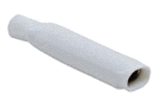I'm in the process of replacing a wired alarm with the Ring retrofit kit. The wiring for the contacts and sensors is just wires spliced with crimp-on connectors. I'm currently chasing down intermittently failing sensors, and the crimp-on connectors and tangle of wires is annoying. Is there a commonly accepted alternative way to connect the wires together to create the zones? I'm considering repurposing a 66 or 110 punch block.
-
I just sourced a Wago splice for 24 gauge and larger of stranded or solid wire. Would that work? What gauge is this stuff? Solid or stranded?– pophamCommented Feb 5 at 17:56
-
And how many wires at each junction?– pophamCommented Feb 5 at 18:13
-
Your question isn't clear. The Ring thing needs bare wires, you can cut off your connectors. If you have large numbers of sensors connected into single channels using some kind of messy system, the question has nothing to do with Ring and you should add photos here or post a new question about that. Whether you ultimately use twist nuts, terminal strips, punch down blocks, wagos, etc is largely up to you. For wires smaller than #18, terminal blocks or IDC connectors would be better. Twisties will break the wires and Wagos will let go unless you buy special ones.– jay613Commented Feb 5 at 18:31
-
I've never seen a 66 or 110 block used for this, but it could probably work fine, if the wire is right for it. They generally need solid, not stranded wire, and within a particular range of sizes. I would guess your alarm wire is stranded; in that case I wouldn't try it.– Glenn WillenCommented Feb 5 at 22:22
2 Answers
You don't indicate what gauge wiring you're talking about, but alarm wire is normally pretty small. I'd imaging that properly crimped connectors will be far more secure than wire nuts or Wagos, and they'll take up less room since they're in-line and not "3-dimensional" to the direction of the wire.
If the wire is tangled, take this opportunity to sort it out and tidy it up. You can use Velcro ties, zip ties, wiring loom or any other method of neatening things up.
Unfortunately, the few wired security systems I've peeked into were always wired as you've described so I've never seen "pros" do it any other way. The "B-splice" connector is a popular choice because its barbed interior pierces the insulation on a conductor, saving the installer the trouble of stripping insulation. (Photo: www.discount-low-voltage.com)
It's often the case that several pairs of wires need to be connected in series so that multiple sensing points can be attached to a single zone input. A 66-block would provide a reasonable way of accomplishing this. You'll need to check the wires, though: I've only ever used 24 gauge solid in a 66-block; I don't know whether stranded or another gauge would work well.
When I wired my own I landed each conductor of each cable run into its own position on a barrier terminal block (all on a single side of the block). These do have the advantage of accepting a wide range of wire types/sizes. I then placed jumper wires on the opposite side of the block to accomplish the series connections. (Photo: mouser.com)


